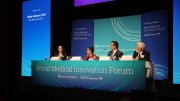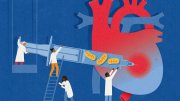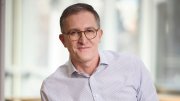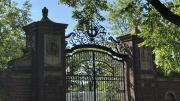As a young professor of chemistry at Harvard in the 2000s, David Liu was trying to accelerate evolution.
This quest took place on the cellular level. Inside every cell in the body, molecules known as proteins act like tiny machines, carrying out biological functions—their efficiency honed by eons of natural selection. And scientists had discovered ways to engineer proteins that were even more efficient, or were built to fix specific problems.
But the work of changing the makeup of a protein was slow: a graduate student would chivvy evolution along by hand, painstakingly altering the experimental conditions once a week or so, and it would be a year before they’d know whether the whole thing had failed or succeeded.
Now, Liu turned a thought over in his mind: could a clever researcher press fast-forward on the process so dozens of new forms rose and fell in the space of a day?
Liu and his graduate student Kevin Esvelt envisioned a way to do this by using a phage—a type of virus that infects bacteria, whose life cycle, crucially, can be as short as 10 minutes. By giving a phage instructions to create a specific protein, then rewarding subsequent generations that successfully produced that protein, they were able to replicate the natural selection process with surprising speed.
In 2011, when the team announced their results in Nature, they could run 200 generations in about eight days. In less than one week, they evolved three new enzymes, their purposes custom-designed by Liu and his colleagues. This process, called phage-assisted continuous evolution, or PACE, has since become a powerful tool for scientists working to advance research and cure diseases. “[It] really reminds me of some of the real classics in the field,” says Jennifer Doudna, Ph.D. ’89, S.D. 2023, a professor of biochemistry at the University of California, Berkeley and a recipient of the 2020 Nobel Prize in Chemistry.
Since then, Liu—now Cabot professor of the natural sciences—has become a leading pioneer of inventive processes that operate on the molecular level in living organisms. He has also become renowned, in his lab and beyond, as a scientist who seems to be in perpetual motion: existing on little sleep, spinning off on side pursuits, and developing companies to springboard his laboratory insights into real-world use.
During the past 18 months alone, two treatments based on his research—one for a genetic lung disease, the other for a lethal metabolic disorder—have made headlines, as did advanced mouse studies focused on curing progeria, a disease that makes children age prematurely. And there’s more to come.
Today, Liu’s office at Harvard is decorated with things that move and toys and oddities that spin in the air. (Liu is also the Merkin professor at the Broad Institute and a Howard Hughes Medical Institute investigator.) Their persistent energy matches that of the man himself—the same energy that was evident from his youth. Liu grew up in Riverside, California, where orange groves and desert stand side by side. He remembers his father, an aerospace engineer, leaving at 4 a.m. for a two-hour commute to El Segundo, the aerospace hub where his company was located. Liu’s mother, a physics professor, held down the fort at home with Liu and his sister and became one of the first female tenured faculty members in her department at the University of California, Riverside.
Liu’s parents didn’t exert pressure on their son to be a scientist. It was his childhood spent outdoors, watching the natural world, that set him on that path. All day at school he looked forward to going out into his backyard, a wilderness of weeds and insects. He was particularly fascinated by ants and their ability to somehow leave trails, invisible to humans, for each other to follow. Was it possible, he wondered, to remove whatever chemical it was they sensed and lay a new path to somewhere else? “I wanted to ask and answer my own questions,” he says. “I was curious about how things worked.”
At 18, Liu participated in the Junior Sciences and Humanities Symposium and won a trip to the 1990 Nobel Prize award ceremony in Stockholm. There, he watched Harvard chemist E.J. Corey give his Nobel lecture. Corey is a mastermind of organic synthesis—the branch of chemistry that uses complex cascades of reactions to build molecules. Afterwards, Liu, then a freshman at Harvard, approached the Nobelist.
“I asked him a question about insect juvenile hormone,” Liu recalls. How could one part of this molecule change, while other parts, apparently identical, stayed untouched? Corey explained that he knew how the molecule would fold up, protecting some areas, exposing others to change.
“It was pretty awesome, which just made him seem even more like some kind of chemistry god to me,” Liu recalls. He exhales, a little self-consciously, and continues, “Then I asked him, while we were at this Nobel Prize lecture, if I could work in his lab.” Corey gently suggested that Liu take some organic chemistry classes first, then check in with him later.
With the help of his organic chemistry professor, Joseph Grabowski, Liu made Corey’s acquaintance again at Harvard, eventually joining his research group. With the elder scientist’s blessing, he decided that the place for him was where chemistry met biology. As a graduate student, he studied at the University of California, Berkeley with chemistry professor Peter Schultz, who had been tinkering with the genetic code to build proteins in a test tube that did not occur in nature.
“I wanted to ask and answer my own questions. I was curious about how things worked.”
—David Liu
Liu started working on getting such a system up and running in living cells, developing a process—which penalized cells with enzymes that functioned normally and rewarded cells with those that acted unusually—that would reshape protein evolution in the laboratory. Other scientists noticed: after earning his Ph.D. in 1999, he was hired at Harvard as an assistant professor.
“It was an interesting time. I had no idea what I was doing, which may have been the biggest source of awkwardness,” Liu recalls. “But also now, only five years after leaving Harvard as an undergrad, I was suddenly a colleague of all of these professors.”
He didn’t want to presume, so he defaulted to extreme deference. “I would say, ‘Oh, thank you, Professor Schreiber, for that comment. Thank you, Professor Corey.’ And I remember, after one of the faculty meetings in my first fall, one of the professors pulled me aside and said, ‘David, we think you should just call us by our first names.’”
As he got his research group off the ground, Liu wanted to continue evolving proteins. He was particularly inspired by a paper from Martin Wright and Gerald Joyce at the Scripps Institute, which focused on the molecules of RNA. Lab evolution of both custom proteins and custom RNAs had always taken a long time. But Wright and Joyce, remarkably, set up a system where all day and night, the RNA continuously evolved, spinning through about 300 generations in 52 hours. “I just thought the idea was so amazing,” Liu says, “and it remains one of the most beautiful papers I’ve ever read.”
He showed it to Esvelt as they brainstormed a way to evolve proteins with similar speed. Esvelt had the idea to start with a virus called the filamentous bacteriophage, which infects the bacterium E.coli. First, he put a gene for a protein he wanted to evolve into the virus. Then he took some of the machinery the virus needed to live and put it in E.coli. Finally, he engineered the E.coli so that it would only hand over what the virus needed if that targeted protein was produced at high levels.
The virus faced enormous pressure to make this protein. At the same time, each generation provided a new chance for interesting new mutations in the gene to creep in. By speeding up or slowing down the flow of fresh host cells into a vessel called the lagoon, Esvelt controlled the pace of the evolution.
It was an intense period in Esvelt’s life—Liu, he says, seems to need only about four hours of sleep a night, and they were often trading emails and ideas at unusual times, racing to generate new data in order to apply for funding for the next phase of the PACE project.
“We never lost hope at the same time,” Esvelt says. “I persisted in the times when he had lost it, and he kept me going through the more frequent times when I was frustrated.”
With PACE, Liu had a way to evolve enzymes with custom purposes. Having done this, Liu set his sights on another ambitious target: editing the code of life itself. It was around this time that CRISPR-Cas9, a system for cutting the genome, was first being described—Doudna, one of its developers, recalls talking with Liu about it early on. CRISPR tools allow scientists to bind and snip DNA and introduce other genetic material.
CRISPR on its own is not a medicine, however. “I quickly realized that most of the genetic diseases that one might want to treat with genome editing could not be treated [only] by cutting DNA, because cutting DNA disrupts the gene,” says Liu. “Instead, they needed to be treated by correcting a mutation back to a healthy sequence.” What if, he wondered, we could make enzymes that would actually reverse a mutation chemically?
DNA can be pictured as two long ribbons of letters, running parallel to each other. Each letter stands for a particular type of nucleic acid base, and each base has its own partner on the matching ribbon: adenine (A) binds to thymine (T), and cytosine (C) binds to guanine (G). Many dangerous mutations are the result of a simple alteration of one pair of bases. Sickle cell anemia, for instance, is the result of an A turned to a T.
With postdoctoral fellow Alexis Komor, Liu discussed ways to alter a mutated base pair back to the healthy version. Komor brought three elements together: an enzyme that could alter a single C, a targeting system from CRISPR-Cas9 to aim it at the right part of the genome, and another protein that solidified the change. In 2016, she and Liu described using this setup to cleanly convert a C:G pair to an A:T pair in living cells, without the organism missing a beat; the double helix was never sliced.
A flurry of innovation filled the next few years. In 2017, Liu and graduate student Nicole Gaudelli described a technique for going the other way: making an A:T pair into a C:G pair, an effort Liu attributes to “heroic” work by Gaudelli. And in 2019, Andrew Anzalone and Liu published another method for tackling yet more mutations. Anzalone, also a graduate student, completed his complex project in a year and eight days.
The response from scientists exploring gene editing to correct diseases was immediate. “It’s a great tool for the field to be able to make targeted changes in one step,” Doudna reflected. There have been at least 23 clinical trials using the techniques, focusing on illnesses ranging from lung cancer to metabolic diseases.
Targeted editing could help with more than just genetic diseases. Because Liu’s techniques provide very precise, clean ways to alter DNA, they can improve existing treatments where DNA is edited, such as CAR-T-cell immunotherapy for cancer. In this treatment, a patient’s own immune cells are removed from the body and given genes that allow them to make antibodies against their specific type of cancer cells. When the immune cells are reintroduced into the patient’s body, they hunt down the cancer, often curing the disease altogether.
In 2021, Alyssa Tapley, a 12-year-old in England, was diagnosed with leukemia. Chemotherapy and a bone marrow transplant failed. In 2022, she had a few weeks left to live when her hospital arranged for her to join a trial using Liu’s techniques. Her immune cells were altered so they could target the cancer cells, and Tapley lived. She is still alive and cancer-free. In April 2025, when Liu was awarded the Breakthrough Prize, a major international science award, Tapley attended the ceremony.
Liu brings the same kind of intensity he displays in his research to other aspects of life. His office is lined with geological specimens, labeled with information about where they were collected, which he gives away to his students as, one by one, they graduate. “When I first joined,” Esvelt recalls, “he had taken up painting and become quite good at that. Then he took up woodworking and installed a giant lathe system in his basement and made some really amazing wooden bowls out of various pieces of wood that he found while hiking or walking along the beach.”
Next came an exploration of photography and optics. “You can sort of sense,” Esvelt says, “he wants to be able to do everything.” (“Ask him about his skills in poker,” Doudna suggests.)
On average, Liu’s lab publishes a paper nearly every 17 days and has maintained this pace for about five years.
That ceaseless energy shapes the environment of his lab, where he long ago stopped hiring people for specific achievements but instead focused on bringing in researchers he thought would work well with others. Although the goal was never publishing for publishing’s sake, on average, he estimates, the lab publishes a paper nearly every 17 days and has maintained this pace for about five years.
“What made it so fruitful is that he just really allowed me and others to be who we are,” says Gaudelli. “There was a sense of freedom.” She felt that there was a current of quiet confidence running through the lab; if you could imagine something, you could build it.
“He has this internal locomotive,” Anzalone adds, “that really pushes him to get the most.” He laughs, remembering the time when he and Liu were preparing to submit their gene editing paper. Liu would wake up at 4 a.m. and edit Anzalone’s draft. During the day, Anzalone would perform more experiments, chasing down final details. At night, Anzalone would add to the draft, working until about 2 a.m. Two hours later, Liu would be up to work on it again.
In March, news broke that one of Liu’s editing techniques had helped do something remarkable: researchers had used it to cure a baby boy’s lethal metabolic disorder. It was an astounding achievement that demonstrated the potential that stems from basic science.
At the same time, the Trump administration was beginning its campaign against science funding. Billions of research dollars have since been frozen or canceled nationwide; a federal judge recently ordered the administration to reinstate more than $2 billion in funding to Harvard, though the White House said it plans to appeal the ruling. Now, Liu is very worried about how to protect the next generation of scientists from the storm. Students and postdoctoral researchers need time and freedom to think, he says, to live without fear that their institutional support will just evaporate.
Even before federal funding for research was suddenly stripped from labs across the country, the frailty of the support system for young scientists concerned him. In 2020, after fruitlessly exploring other avenues for securing better pay for his lab members, Liu quietly decided to start dividing his salary among them every year.
Liu has co-founded many companies, three of which are publicly traded. Anzalone, after finishing his doctorate, went on to help lead Prime Medicine, a new start-up co-founded by Liu to commercialize the gene editing technique they’d developed together. Along with CRISPR pioneers Doudna and Feng Zhang, Liu also helped found Editas Medicine, which explores ways to use this technology to treat serious diseases. Gaudelli joined Beam Therapeutics, where she spent the past few years advancing a gene editor that may be used to treat sickle cell anemia. (She has since moved on to become an entrepreneur in residence at Google Ventures.)
“Accumulating wealth is not anywhere in the top 100 things I want to do,” Liu says. “My students and the work that we do, and the patients who reach out, and the families like Alyssa [Tapley]’s—these are all so much more meaningful than how many digits are in a bank account.”
And while Prime, Beam, and Editas are vehicles that aim to produce treatments and medicines that change lives, he notes, they draw their strength from the academic science that was their inspiration. Their vigor is linked to the freedom scientists have to imagine things that have yet to exist.
“Science matters,” Liu says. “Universities matter.” Enormous dividends are paid over decades by the funding of young scientists just getting underway, just beginning to imagine what comes next, Liu says, “who will go on to make their own discoveries, or to teach, or to work in industry to help develop the next great drug.”
Gaudelli thinks back to the way the Liu lab seemed to encourage transformative thinking, such as the idea that a letter of genetic code could be changed almost as easily as a light switch can be flipped. “I was allowed to imagine something that seemed impossible,” she says. “And then, one day, it was not.”









